| Author: | |
| Website: | |
| Page title: | |
| URL: | |
| Published: | |
| Last revised: | |
| Accessed: |
The first type of game storage medium to be used with game consoles (and the most widely used until the mid 1990s) was the game cartridge. The cartridge consists of a printed circuit board (PCB) mounted within plastic case, and a connector is provided to allow the cartridge to be plugged into the console. The game software resides on a read only memory (ROM) chip on the PCB, which may also be equipped with specialised game hardware components and additional RAM.
The Nintendo 64 was the last mainstream game console to use cartridges (an example is illustrated below). Once plugged into the console, the game software could be directly accessed and executed by the console without the need to load it from secondary storage media such as magnetic tape, or magnetic or optical disks. The robust form factor meant that cartridges were not easily damaged, unlike cassette tapes, floppy disks or optical media.
On the other hand, manufacturing costs were relatively high, partly due to the proprietary (and incompatible) formats used by different console manufacturers. Cartridges were eventually replaced by optical media such as CD-ROM and DVD-ROM, which were cheaper to produce and provided far more capacity.
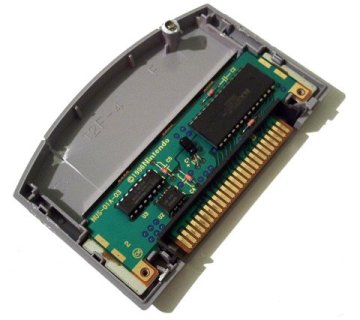
Inside a standard Nintendo 64 game cartridge
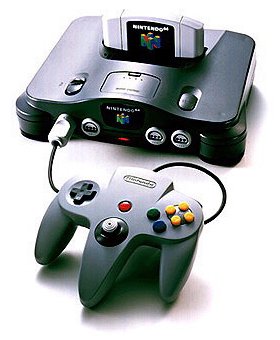
A Nintendo 64 console with mounted cartridge
The Sega Master System (first released in 1986) was one of a small number of consoles to use a game card in addition to the standard cartridge format. These cards were approximately the same size as a credit card and, though initially envisaged as being cheaper to produce than cartridges, were limited to a 32 kilobyte capacity.
Although similar in principle to cartridges, the small form factor made the inclusion of additional components impractical. Lack of support for the format meant that the use of game cards was discontinued for the Sega Master System 2. Both the Nintendo Game Cube and the PlayStation 2 have used memory cards to provide additional storage, but in recent years only the hand-held Nintendo DS has employed them for game distribution.
For some early home computers like the Sinclair ZX81 (released in 1981) and the ZX Spectrum (released in 1982), programs were stored on audio cassette tapes and loaded into the computer's memory via an ordinary cassette recorder.
The advantage of using audio tapes to distribute game software was chiefly related to cost and availability. The data was encoded using audio tones by means of a simple pulse-width modulation scheme in which audio-frequency pulses of different lengths represent the binary digits one and zero. The average data rate was in the order of 1,365 bits per second, which meant that programs could often take several minutes to load.
Because of their construction, audio cassette tapes are more susceptible to mechanical damage than either game cartridges or optical media, and the loading process, though usually quite reliable, could result in failure due to issues such as the volume on the cassette player being set at the wrong level.
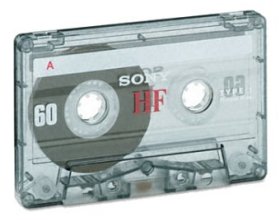
An audio cassette tape
The floppy disk drive (FDD) has been around since the late 1960s, and 5.25 inch floppy disks were used to load programs and data into the first IBM Personal Computers (the IBM PC first appeared in 1981). The 5.25 inch format, which could hold 360 kilobytes of data, was later superseded by the 3.5 inch diskette which initially held 720 kilobytes, and later (in its high-density form) 1.44 Megabytes.
For many years, software for personal computers (including game software) was distributed on floppy disks. It was not until the mid 1990s that the increasing size of software programs and the falling cost of optical drives and media lead to the CD-ROM replacing the floppy disk as the medium of choice for the distribution of software. The "floppy disk" itself is a thin, flexible magnetic disk housed within a rigid plastic case.
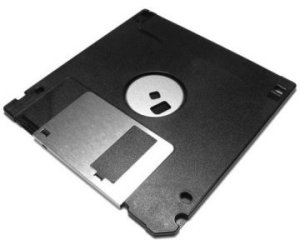
A 3.5 inch floppy disk
In the mid-1990s, various manufacturers shifted to optical media, specifically CD-ROM, for games. Although they were slower at loading game data than the cartridges available at that time, they were significantly cheaper to manufacture and had a larger capacity than the existing cartridge technology. By the early 21st century, all of the major home consoles used optical media, usually DVD-ROM or similar disks, which are widely replacing CD-ROM for data storage.
The Nintendo GameCube used a miniDVD disc format that can also be used in the Wii. The disc is eight centimetres in diameter and has a capacity of 1.5 GB, and a proprietary format that was chosen to discourage piracy, reduce game load times, and avoid the payment of licensing fees to the DVD Forum. As a result, the disc cannot be used on other game platforms.
The Wii uses a standard twelve centimetre DVD, again with a proprietary format, but with a much greater capacity (4.7 or 8.54 GB, depending on whether the disc is single or double-layer). The PlayStation 3 system uses even higher-capacity Blu-ray optical discs for games and movies while the Xbox 360 formerly used HD DVDs in the form of an external USB player add-on for movies, before it was discontinued. Microsoft still however, supports those who bought the accessory. The Xbox 360 includes a built-in DVD-ROM drive.
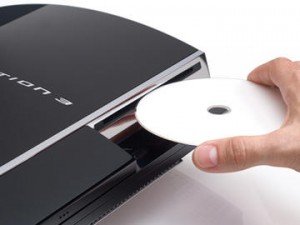
A PlayStation 3 optical drive
A hard disk drive is a non-volatile storage device found in most modern computers that stores data on rapidly rotating magnetic disks (called platters). The drive is usually a sealed unit, and the most common nominal sizes are 3.5" and 2.5". Hard disk drives have now been included with a number of popular game consoles.
One notable exception is the Nintendo Wii, which provides 512 megabytes of internal flash memory and two memory card slots for external storage. The card slots can accept either SD or SDHC cards as well as a GameCube memory card, giving a potential removable storage capacity of 32 GB that can be used to store saved game data or game software.
Microsoft's Xbox 360 has a 2.5" hard disk drive mounted on the top of the console unit inside a proprietary snap-on module (see below). Drive capacities for the Xbox 360 depend on model, and the range available includes 20, 60, 120 and 250 gigabytes. The original Xbox, incidentally, was the first game console to include a hard disk drive (this was a standard 3.5" drive, and no doubt contributed to the considerable bulk of the original Xbox console).
The Sony PlayStation 3 console includes an upgradeable 2.5" SATA hard drive. Unlike the Xbox 360, the PS3 can accept any standard 2.5" SATA hard drive. A number of versions of the console have been released over the years since it first appeared, including a slim model in late 2009. The original configurations included a 20 GB model and a 60 GB model. Other variations have included 40, 80, 120, 160 and 250 GB hard drives. The PS3 slim model is currently the only model in production (as of 2010), and is available with a 120 GB or 250 GB hard drive.
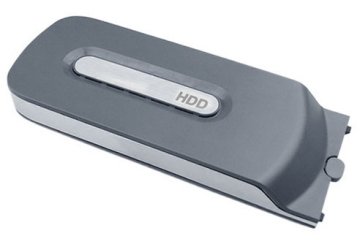
An Xbox 360 hard disk drive